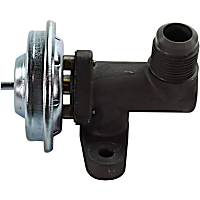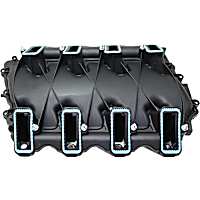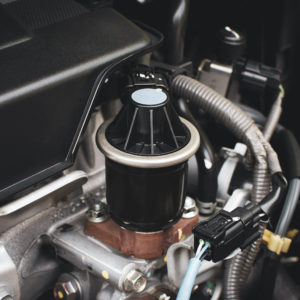The error code P0401 is one of the 20 most common OBD-II codes faced by a lot of car owners, although it can be more prevalent in certain makes, such as Toyota and Honda vehicles.
Learn more about what a P0401 code means and how you can diagnose and fix the underlying problem that’s causing it.
What Does the P0401 Code Mean?
Diagnostic trouble code (DTC) P0401 stands for “Exhaust Gas Recirculation (EGR) Flow Insufficient Detected.” This code means that the computer detects insufficient exhaust gas recirculation (EGR) flow in the system.
If by looking at the feedback loop (whatever it may be on the system in question), if the ECM/PCM determines there is insufficient EGR flow, it will set the OBD-II code P0401. Usually on an OBD2 system that sets the P0401, the ECM/PCM must see the failure on two consecutive trips before it will permanently set the code and trigger the Check Engine Light.
The EGR system is important because it reduces emissions by allowing burnt exhaust gas to flow back into the engine. This helps lower your engine’s combustion temperature for a reduction in oxides of nitrogen (NOx) emissions.

To learn more about how the EGR system works and how it developed as an emission control technology, check out our in-depth look.
P0401 on Some Ford Vehicles
Code P0401 may appear on some Ford vehicles. On a 1999 Ford F-150 5.4L V8, for example, this DTC can be triggered by the following issues:
- Vacuum supply
- EGR valve stuck closed
- EGR valve leaks vacuum
- EGR flow path restricted
- EGRVR circuit shorted to PWR
- VREF open to DPF EGR sensor
- DPF EGR sensor downstream hose off or plugged
- EGRVR circuit open to PCM
- VPWR open to EGRVR solenoid
- DPF EGR sensor hoses both off
- DPF EGR sensor hoses reversed
- Damaged EGR orifice tube
- Damaged EGRVR solenoid
- Damaged PCM
The EGR system is monitored during steady state driving conditions while the EGR is commanded on. The test fails when the signal from the DPF EGR sensor indicates that EGR flow is less than the desired minimum.
For diagnostic aides, it is advised to perform a KOER self-test and look for DTC P1408 as an indication of a hard fault. If P1408 is not present, look for contamination, restrictions, leaks, and intermittents.
What are the Possible Causes of the P0401 Code?
Code P0401 is experienced by all car types that have on-board diagnostics. Trouble codes on cars with pre-OBD-II systems may vary depending on the make and model year.
Here are the common causes of P0401:
- Clogged EGR passages
- Faulty EGR valve
- A failed sensor (e.g., differential pressure sensor, manifold absolute pressure sensor, etc.)
- Inadequate vacuum supply to the EGR valve
- Circuit problems, such as damaged wiring and loose connections
- Issues with the PCM, such as software in need of an update

What are the Common Symptoms Of The P0401 Code?
You may begin experiencing these symptoms if your computer’s giving you a P0401 code:
- Illuminated malfunction indicator lamp (Check Engine Light)
- Failed emissions test
- Engine knocking or pinging during acceleration
How to Diagnose the P0401 Code
Obviously, there is more than one potential reason that a code P0401 might be set, and diagnosing the root cause can be a little tricky for the untrained eye. If you’re not confident with the technical knowledge you have, seek a certified mechanic’s help instead of fixing the problem yourself.
But if you would like to diagnose the problem yourself, check out the videos below to get an idea of how to troubleshoot a P0401 code:
How to Fix the P0401 Code
There’s more than one way of fixing any issues with your car, especially if you’re dealing with OBD-II codes. The exact repair would depend on the root of the problem, and there are multiple reasons why code P0401 might be stored.
Unfortunately, there isn’t a “magic bullet” fix for the issue. You’ll need to diagnose the code accurately to find out what’s triggering the P0401 in your vehicle before you can figure out your plan of attack.
Also, keep in mind that all vehicles are different. When troubleshooting and repairing diagnostic trouble codes, you should consult the factory repair information for your application.
Repair manuals, such as those from Chilton, are useful, but an ALLDATA subscription is even better. ALLDATA has single-vehicle subscriptions for DIYers that provide detailed factory repair information.
P0401 Repair Costs
Code P0401 warns of problems with your EGR system, from a faulty valve to a dirty temperature sensor. The severity of the problem varies depending on the extent of the components affected.
Total repair costs range from $150 to $750, inclusive of labor and parts. It is important that you pay close attention to your vehicle’s warnings. If you get a P0401 trouble code, immediately schedule an appointment with your trusted mechanic.
Sample Issue: P0401 In a Toyota Prius
As previously mentioned, the issues causing the P0401 can vary. For example, according to a Toyota service center, a faulty differential pressure sensor is a typical trigger for this trouble code in Toyota Prius units.
Some Prius owners also reported that the culprit for this code in their car is a bad EGR valve motor. After switching the motor, the trouble code was cleared, and it didn’t trigger again.
Other possible causes include carbon buildup in the EGR tube, a faulty EGR valve, or a lack of vacuum to operate the EGR valve.
Resolving this trouble code involves ensuring the EGR passages are clean and then testing whether EGR components like the EGR valve are operating properly.
An In-Depth Look at the EGR System
The ambient air drawn into the engine is 78% nitrogen, 21% oxygen, and a lot of trace elements. That’s important information for those who want to understand why Exhaust Gas Recirculation came about as an emission control in the early 1970s.
The ambient air drawn into the engine is 78% nitrogen, 21% oxygen, and a lot of trace elements. That’s important information for those who want to understand why Exhaust Gas Recirculation came about as an emission control in the early 1970s.
–Richard McCuistian, ASE Certified Master Automobile Technician
During an ignition event, combustion chamber temps when the engine is under load can surpass 2,500° F (1371° C), and at those temperatures, the molecules of inert nitrogen superheated by the uniting of O2 with HC can bond to some of the O2 molecules to form oxides of nitrogen (NOx). An x is used rather than a number because one molecule of N can bond to various different numbers of O molecules; the number isn’t always the same, thus the term OXIDES of nitrogen. NOx is not our friend – so the EGR system was designed to mostly prevent it from forming in the first place. The light-off catalyst takes care of any NOx that manages to form in spite of EGR.
Since exhaust gas leaving the combustion chamber is inert (meaning it won’t burn), about 5% of the exhaust gas on average is recirculated to prevent the combustion chamber temperatures from exceeding the 2500 threshold, but EGR on a gas burner only opens when the engine is off idle and under load. The exhaust gas usually travels through a steel pipe from the exhaust manifold to the valve, which provides the exhaust gas to cool just a bit as it flows.
What is an EGR Valve?
The EGR valve is a device with an internal pintle that is lifted off its seat to allow that very small amount of exhaust gas to enter the intake stream. The earliest EGR valves developed for carbureted engines use a vacuum diaphragm to open the pintle when the throttle is opened, with the vacuum passing through a thermal vacuum switch on its way to the diaphragm. The thermal switch prevents EGR flow when the engine is cold.
The exhaust flow into the intake stream happens very naturally when the EGR valve is open, because the pressure in the exhaust is always greater than the pressure in the intake when the engine is running. Typically the recirculated exhaust will be fed into the intake right behind the throttle plate or through a very small port in each intake runner to make sure every cylinder gets exactly the same amount of EGR flow. Sometimes on the small-port systems (some Nissans and Fords have this), a few of the ports will clog, causing a surge or an engine skip due to uneven EGR delivery between cylinders.

The problem with that early system was that the EGR could be working or not working and nobody would be the wiser. Granted, some engines will ping (labor knock) when EGR is not flowing, but some won’t. Later EGR valves use small electric motors internal to the valve and a three-wire feedback sensor to report EGR pintle position.
EGR in Pre-OBD2 Vehicles
Pre-OBD2 GM vehicles will watch O2 sensor activity while the ECM is commanding EGR flow, because O2 sensor readings will drift slightly rich when EGR is flowing due to the displacement of oxygen by the inert exhaust gas entering the intake. Pre-OBD2 Ford engineers developed a different feedback system, with a 3 wire pressure sensor that first appeared on Lincoln Town Cars in 1991. That sensor has two silicone hoses connected to the EGR feed pipe with an orifice between the two hoses. When EGR is flowing, the pressure will rise in the hose connected below the orifice and drop in the hose connected above it, thus the Engine Controller (ECM/PCM, etc.) can determine if EGR is flowing and how much.
Pre-OBD2 Asian vehicles are often fitted with a two wire EGR temperature sensor that will report hot exhaust gas when the valve is open – or the lack of hot exhaust gas if there is no flow.
These feedback methods are all about closing the loop. OBD 2 systems are required to monitor EGR flow and store a P0401 code if exhaust flow is insufficient.
How To Get a Replacement EGR Valve for Your Vehicle
You can still drive your vehicle with a faulty EGR valve, but it’s hardly worth the risk. Ignoring a defective EGR valve can cause rough idling and stalling. You’re also likely to end up with extra unburned fuel in your exhaust system, which can damage your catalytic converters and oxygen sensors. In other words, you’re looking at a bigger repair bill if you ignore the issue for too long. Luckily, you can get a new EGR valve from CarParts.com with just a few clicks.
Take the hassle out of ordering a new EGR valve by using our vehicle selector and search filters to find exactly what you’re looking for. CarParts.com also guarantees fast shipping, thanks to our strategically located warehouses around the US. You can even expect your new EGR valve to arrive in as fast as two business days as long as you order by 12 p.m. ET.
Don’t wait until your EGR valve damages other parts of your exhaust system. Check out our wide selection of quality EGR valves at CarParts.com today.
Products Mentioned in this Guide
Any information provided on this Website is for informational purposes only and is not intended to replace consultation with a professional mechanic. The accuracy and timeliness of the information may change from the time of publication.




 EGR Valve
EGR Valve
 Exhaust Manifold
Exhaust Manifold
 Intake Manifold
Intake Manifold


















